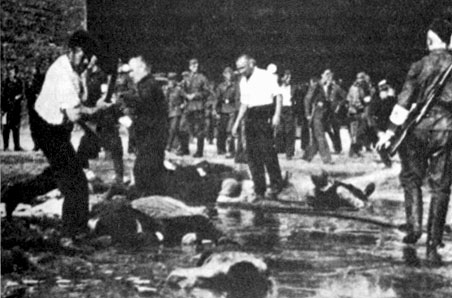O P I N I O N / E Y E W I T N E S S A C C O U N T
by Julius Norwilla
◊
To mark the 74th anniversary of one of the iconic events of the Lithuanian Holocaust, the infamous Lietūkis Garage Massacre of 27 June 1941, the Kaunas Jewish Community organized its annual memorial event at the site, last Friday, 26 June 2015. The massacre, carried out by local Lithuanian “patriots” wearing the white armbands of the Lithuanian Activist Front (LAF), butchered dozens of Jewish passers-by at a garage on Kaunas’s Vytautas Avenue, using a variety of execution methods, including clubbing to death with crowbars, and particularly, forcing water from high-pressure hoses into bodily orifices of the victims until they burst. A growing crowd, including women holding up their young children to get the best views, cheered them on.
The memorial event was held in the off-street courtyard entered via Miško Street 1 in Kaunas at 4:30 P.M. on Friday, June 26, 2015. The ambassador and staff of the recently established Embassy of the State of Israel came from Vilnius for the event.
During the Lietūkis Garage Massacre, carried out before the invading Germans had actually set up their administration, more than sixty people were killed and publicly humiliated in the process, for their being Jewish. It was during that last week of June of 1941, when the Soviet army had fled from the onslaught of Operation Barbarossa — the Nazis’ invasion that was the largest in human history — and the forces of Nazi Germany were arriving, and local Lithuanian nationalists were harassing, humiliating, pillaging and massacring Jews in dozens of locations even before the arrival of German forces.
The Lietūkis Garage Massacre on 27 June 1941 is well documented, well photographed, and widely discussed. For the perpetrators, the bloodshed was an act of patriotism: a brave accomplishment carried in the name of Lithuania’s future, for the goal of a Lithuania without Jews. The intentions of the LAF for the Jewish population of Lithuania were set out in a series of leaflets issued before the war. All the more sad that in 2011, on the seventieth anniversary of the events, our government decided to honor the perpetrators’ memory on the grounds that they were supposedly national heroes. There was even a period when the parliament’s English-language website declared 2011 to be a year for remembering the victims of the Holocaust, while the Lithuanian-language website declared it to be a year to remember the LAF “rebels”…
For me, a native of Kaunas (Kovno), it is obvious that the Lietūkis Garage massacre is the blackest page in the entire history of my native city and country as well. But where are the discussions about its significance? Instead of discussion and civic discourse, it is increasingly a sort of public secret, details of which are kept available only for specialists of one kind or another.
The location is in the very center of the city. When entering the courtyard, one sees a proud investment in state-of-the-art sports facilities that border on the ten-square-meter “green” area with four or five bushy pine trees that cover, with their strong and long needles, the shy and slight monument. The acoustics of the area, enclosed by buildings on all four sides, are such that the cheerful sound of balls being dribbled, bounced and thrown are the memorable hallmark of the place. Does such a memorial not belong on the street and not in a play-yard? In 1941, the garage faced the street, of course. Tomas Venclova and others have noted the irony. It was Vytautas the Great (Witold) who gave the Jews the celebrated charter of rights in the fourteenth century. It was the LAF that explicitly abrogated those rights even before the first German soldier arrived, and it was the Lietūkis Garage on Vytautas Avenue where this particular slaughter occurred. It followed others those days in Kaunas, including the murder of thousands in the Jewish neighborhood, Slabodka (Vilijampolė), including the beheadings of Rabbi Zalmen Osovsky and other rabbis.
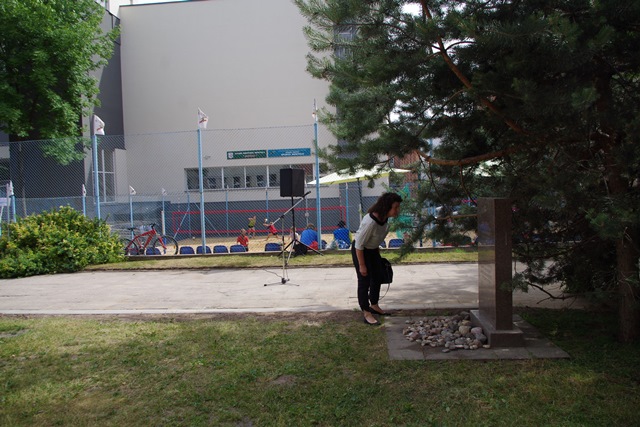
The small monument to the victims of the Lietūkis Garage Massacre is somewhat hidden even within the backyard court where it has been placed. Photo: Julius Norwilla.
On the day of the commemoration event, a sunny Friday afternoon, the volleyball team took care to stop playing and disappear about five minutes before the commemoration started; Thank you. I had the impression that this reluctant departure resulted from the intervention of a municipal worker who whispered a few words in the ear of the elderly volleyball coach.
There were no official representatives of the Lithuanian government, despite its many and expensive efforts to project an international sense of seriousness about commemoration of the Holocaust and a supposed determination to finally tell the whole truth about the local participation.
Governmental absence served to make even more important the Israeli ambassador’s presence. But beyond presence, Ambassador Amir Maimon had a very clear message, and if I am not mistaken, he was the only speaker to make the point that the people who carried out the massacre were citizens of Kaunas. He went on to acknowledge some recent improvements to the site by the Kaunas municipality to honor the memory of the innocent victims, also citizens of Kaunas. But Ambassador Maimon stressed the need to do more.
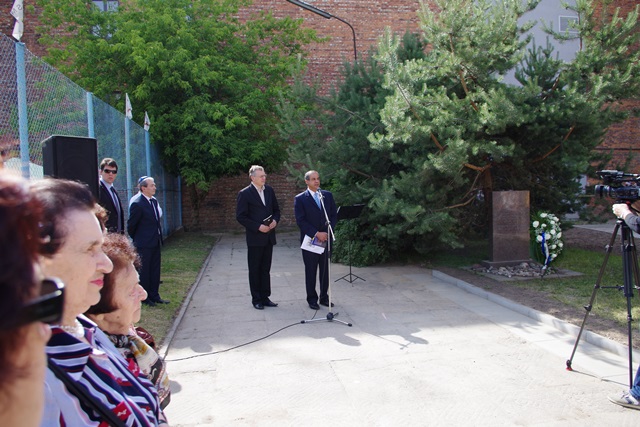
Israel’s Ambassador Amir Maimon (at the microphone) addresses the assembled. Photo: Julius Norwilla.
What was most moving for me was the ambassador’s decision to bravely read the poem by the late Lithuanian dissident poet Aleksandras Bosas on the garage: Lietūkio garažas. Earlier this year, Defending History honored Bosas by publishing a selection of his poems chosen by Milan Chersonski, translated by Ieva Pukelytė-Mikutienė, and edited by Stanley H. Barkan. Here is the English version of the poem that Ambassador Maimon so movingly read:
◊
-
-
In Lietūkis Garage Court
-
by Aleksandras Bosas
- ◊
- Basketball court used for executions.
- Its cover recalls blood-red.
- Painful knowing stings me in the heart,
- Corner here . . . Unfortunately, the same . . .
- ◊
- Darius—Girėnas gymnasium yard—
- sad memories in Lietūkis Garage . . .
- Here the human blood ran in rivers—
- Sadists shattered heads with crowbars . . .
- ◊
- Our women do not howl anymore
- Do not hold babies over their heads.
- Photos not made anymore by the Wehrmacht,
- But, to this day, this square makes me uncomfortable…
- ◊
-
◊
There were some locals among the small crowd (under 100 people) who remarked that about two weeks before the event, the site was finally improved a little from its long-standing dismal appearance. The huge waste containers (dumpsters) were finally removed (hopefully permanently, to another location…), and the car parking area more clearly demarcated so as not to overlap with the memorial for the Garage’s victims. But, sorry to say, this paled taken against the failure of the city’s leaders to come and speak openly and clearly. Not one Lithuanian citizen speaker noted who the perpetrators of the massacre were. No moral judgment. No expressions of national regret. No human, humane or humanitarian statement.
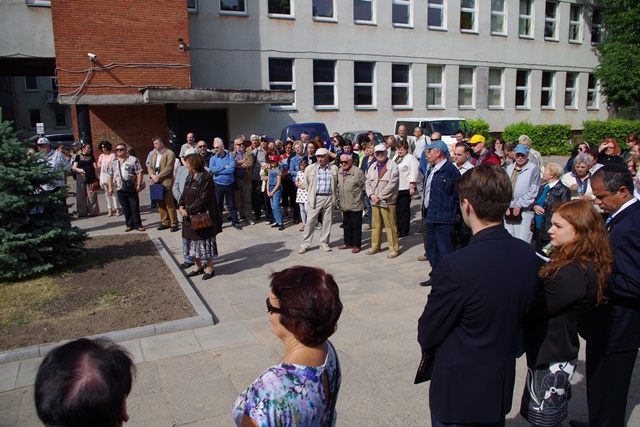
The people who came to participate in the commemoration. Photo: Julius Norwilla.
Looking around I couldn’t help but wonder: Where are students? at least students from the gymnasium (secondary school) right nearby? It seems the youth playing basketball nearby have no idea what the monument is for and what this once-a-year commemoration event is all about. Where are the determined pedagogues? The government’s commission on Nazi and Soviet crimes? The genocide center? The operatives who rush to stress deep care about the Holocaust to visiting Jewish dignitaries from abroad? Municipal staff? National and local erudite historians and academics? As if to answer this privately held question of mine, the last speaker assured us that there are good teachers from nearby schools who bring their students to Lietūkis Garage to commemorate the massacre. He prudently explained, that the good works of recollection of innocent victims are silent, and therefore go unnoticed.
Finally, we have the Kaddish prayer for the dead, in its original Aramaic. There is mention of some of the places of mass murder of the city’s Jews in 1941: Slobodka (Vilijampolė, Yiddish Slabódke), the Seventh Forth, Panemunė, the Ninth Fort. There are more.
But alas, back in Vilnius, on 22 June 2015, just before the commemoration of the outbreak of the war and the Holocaust, a member of our national parliament, MP Paulius Saudargas submits yet a new proposal to “review the interpretation of the newest history.” The idea of the proposal by the parliamentarian is national pride building, based on the “great uprising” of 23 June 1941. This is part of a massive new effort to turn the seventy-fifth anniversary of the events, in June 2016, to yet another sham celebration of supposed rebels against the Soviets. What utter nonsense. The Soviets were of course fleeing the German invasion, not the Jew-killers who murdered thousands of innocent Jewish neighbors that week, setting off the Lithuanian Holocaust. It sometimes seems that our country is still moving the wrong way in coming to terms with the simple truth.
But with most setbacks come new opportunities. Our nation’s leaders will have a splendid opportunity once and for all to condemn those who carried out the Lietūkis Garage Massacre and the murder of thousands of Jews in Lithuania in the week of 22 June 1941, to throw the attempts to make “heroes” out of them into the dustbin of history where they have belonged for the last seventy-four years.
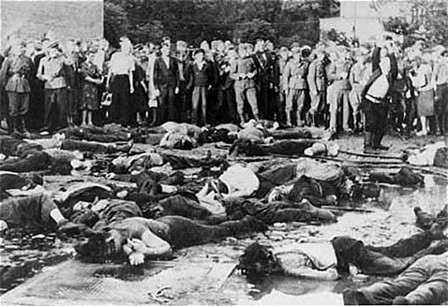
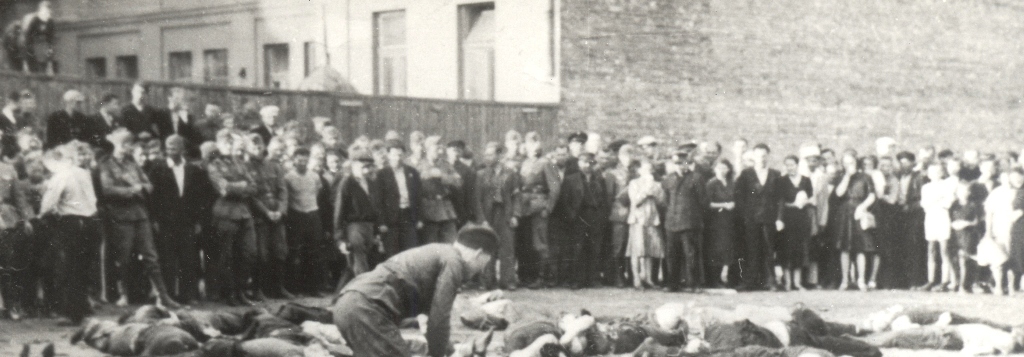
◊
